#bronze sculpture of Secretariat
Explore tagged Tumblr posts
Text
Horses, History & Hospitality in Paris, KY
Want to go to Paris? The question is which one! I have been to Paris France, Paris, Tennessee, Paris, Illinois, and now Paris, Kentucky! The town is known for horses, history and hospitality. The actual motto for this town located in the heart of Bourbon County is “Thoroughbred Capital of the World”. Almost everything, everywhere in Paris, KY is connected to horses! Tractor Show Keith with the…

View On WordPress
#1919 engine#52nd Annual Central Kentucky Antique Machinery Association tractor show#Ardery&039;s Antiques#Aruthur Hancock#Blessing Box#Bluegrass Region#Bourbon County#Bourbon story#breeding season#bronze sculpture of Secretariat#Capt. Richard Hancock#Claiborne Farms#Colville Covered Bridge#Duncan Tavern#Eiffel Tower Paris Kentucky#Explore Kentucky History#Farmall tractor#Farmhouse Peaceful B&B#Hancock Family#Hinkston Creek#history#Hopewell Museum#horse breeding#horses#hospitalty#Jacob Spears#John Deere#Kentucky Derby#Lil&039;s Coffee House#lunch counter
0 notes
Text
Musée d'Orsay & Musée de l'Orangerie
26/04/2018: Toast, coffee and tea for breakfast this morning. To avoid the old French woman, who didn't appear again, we quickly and quietly exited the building and headed to the corner. Today we were looking to visiting the Musée d'Orsay, across the Seine and Musée de l'Orangerie, at the end of Jardins Tuileries. The easiest way to get there was to cross the road at Rue de Castiglione, down the stairs protected by the beasts, and across the gardens along Allée de Castiglione. The footbridge, Léopold Sedar Senghor got us just about to the front door. The Orsay didn't open until nine thirty so we didn't leave the apartment until nine and after advice from the security dudes out front, queued towards the back of the forecourt.

Rhinocéros attaqué par un tigre. One of the beasts
Once the site of the Orsay Railway Station, built for the Universal Exposition of 1900, the building was saved from the wrecking ball by a revival of nineteenth century architecture during the seventies. The station and its hotel's usefulness diminished after the Second World War as the platforms became too short as modern trains become longer. Electrification didn't help neither. It subsequently serviced the shorter suburban trains until its final demise.
An itch in its daddy's pants during the early seventies, Direction des Musées de France officially hatched the museum idea and listed the building on the Supplementary Inventory of Historical Monuments not long after. Musée d'Orsay was officially given the go ahead in 1977 and classified a Historical Monument the following year. The new museum was inaugurated by François Mitterrand at the end of 1986 and is now dedicated to displaying collections of art from the period 1848 to 1914.
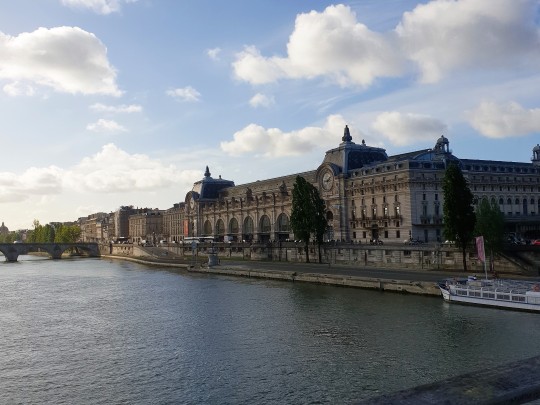
Musée d'Orsay
Studying the gallery map from the concierge, we looked for the lifts that would take us straight to the top and the temporary exhibition of the Neo-Impressionists. The boys took the stairs while the girls took the elevator. Since we were not keeping in contact at that point the girls went on their own tour of the gallery. They saw pretty much what the boys saw but in a different order. The following is how the boys tour of the gallery panned out.
Studying the gallery map from the concierge, we looked for the lifts that would take us straight to the top and the temporary exhibition of the Neo-Impressionists. The lift serviced several floors above the entrance which opened up to the intermediate floors along the main concourse's flanks. That’s where we separated. Being at the top gave us a good perspective of what was ahead. Looking through the braced iron frame and down the length of the building where the platforms and railway tracks once stood. Now covered by great works of art from the more recent periods of history.
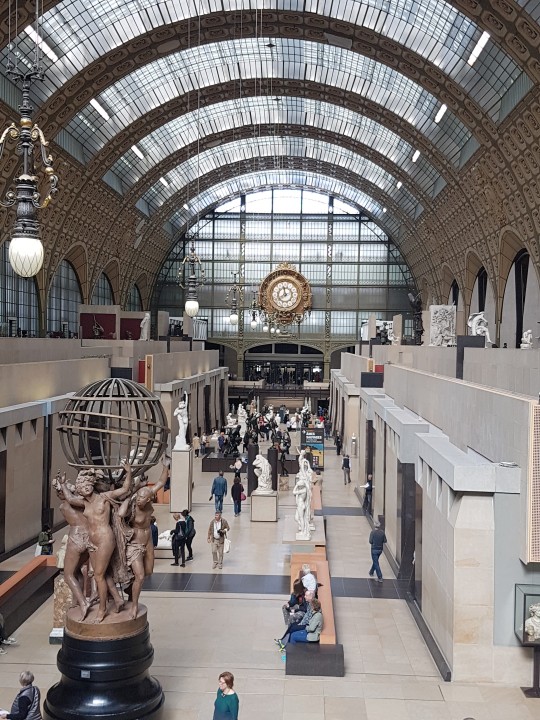
Looking down the old concourse
Interesting first impressions. We were on Level 5 and the paintings in the first Temporary Exhibition, in Salle 36, were just dots of colour, but very good. The founders of the Neo-Impressionist movement, Georges Seurat and Paul Signac were a part of a new generation of creative artists who, during the eighties, championed the scientific art form born from the triumph of Positivism. Furthermore, they developed a technique of painting in very small dots, not unlike our indigenous Aussies back home. But these guys decomposed the work and managed to make the colours vibrate, by juxtaposing complimentary shades and modulating colours to achieve a particular luminosity. It's true, it worked. When we stood back to admire the painting, the orientation of the lines and the spatial arrangement of the planes contributed to the overall harmony and we could recompose the picture. Just as the sign said. The Neo-Impressionists were very impressive.

L'Air du soir, 1893 (The evening air). Henri-Edmond Cross

L'homme a la barre, 1892 (Man at the Helm). Théo van Rysselberghe
Moving through the corridors led us to the next section, Salles 35 down to 29 with the first room mostly dedicated to Auguste Renoir and Paul Cézanne, Impressionist and Post-Impressionist painters respectively. Renoir, apparently from the school of those who painted beauty and feminine sensuality, had plenty on nakedness in his pictures, and few men. Cézanne on the other hand, except for his Bathers series, painted mostly landscapes and clothed people in social gatherings. Salle 34 was full of Monet. Women in boats, plenty of flowers and a few goes at the Cathedral of Rouen filled this room, and of course one of his many paintings of haystacks. We guessed that each haystack gave him a different perspective than the last. Then a small room for Degas. Salle 33 had not much more than a half dozen bronze statues of horses and women.
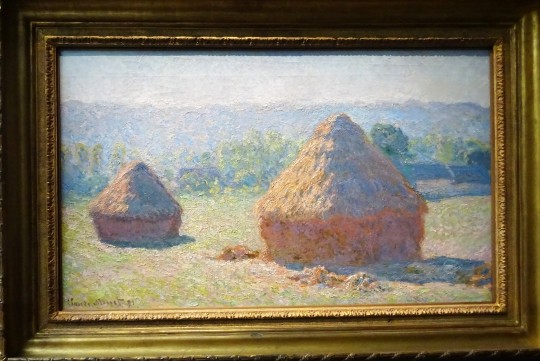
Stacks and stacks of Haystacks
The next room was quite large and was shared with some well known artists. Quite a few Pissaro, the odd Sisley and more Renoir and Monet. Degas and Renoir appeared in Salle 31 with plenty of Degas' ballet and dancing pictures and figures. The rest of Level 5 was more of the same, they all shared the remaining rooms but it was mostly the Monet and Manet show.
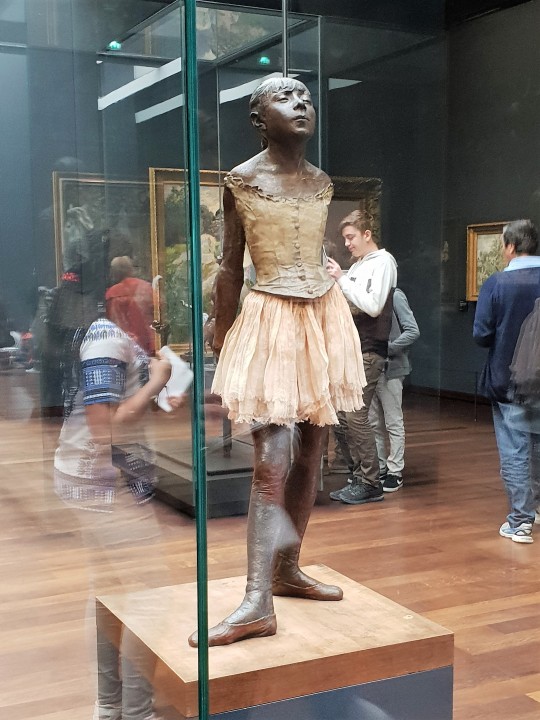
Petite danseuse de quatorze ans. Edgar Degas
Dropping down three floors to Level 2, Levels 4 and 5 were off limits for some reason, administration maybe, the Salles were in their sixties. A large mezzanine floor overlooking the concourse or le Allée centrale des sculptures was full of sculptures and linked the rooms that held a mixture of vases, goblets and more antique like stuff with the most magnificent collection of Art Nouveau Decorative Arts, or what you and we would call furniture. This area was great. The style of the beds, dressing tables, benches, entrances and so on were out there for the age but soon adopted by the French. Designers of today could take a leaf out of the Art Nouveau movement’s book. Maybe we're too conservative.

Nénuphars, Louis Majorelle

Banquette de fumoir (Bench for a Smoking Parlour), 1897. Hector Guimard
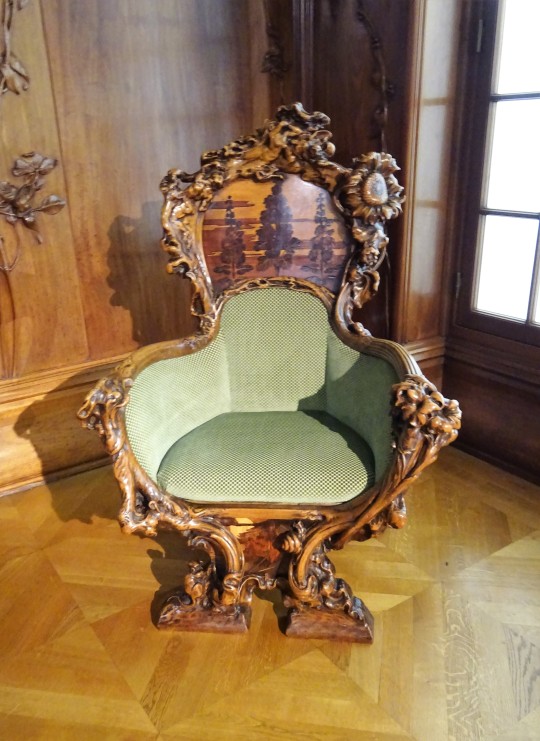
Le jour et la nuit, ~1900 (Day and Night). Georges Rey (apparently). Also "apparently" owned by Sarah Bernhardt
As we weaved in out of the rooms and Terrasse Seine, we moved from furniture that we would love to have in our house, some Salvador Dali type of stuff and a mixture of statues and sculptures from Rodin and other well known artists as well as plenty of little known ones.

Vir temporis acti, Adolfo Wildt
We were finally finished on the northern side, moved across the way and immediately walked amongst the statues on the opposite mezzanine, Galerie Françoise Cachin. Entering into Salle seventy something containing the works of Van Gogh (Dutch post-impressionist psychotic from the late 19th century) and Paul Gauguin, who lived to just after the turn of the twentieth century (French post-impressionist spent last few years of his life in French Polynesia with the locals), we encountered a smorgasbord of two of the greats. The precursor to Starry Night, Starry Night on the Rhone, a Van Gogh self portrait and some lovely paintings of Polynesian locals.
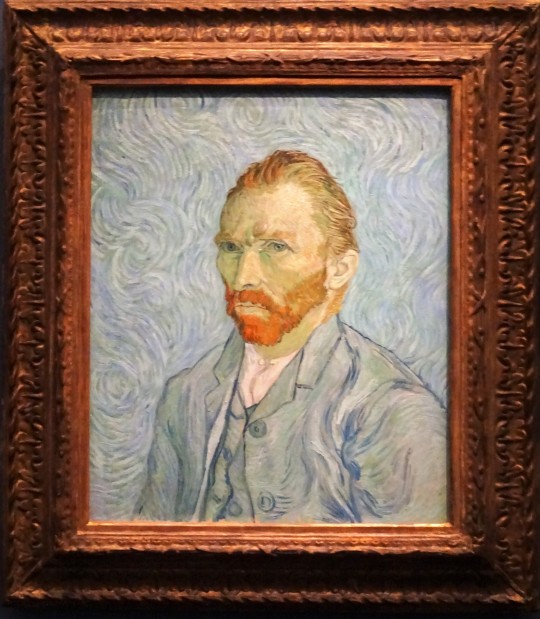
Portrait de l'artiste, Vincent Van Gogh

Femmes de Tahiti ou Sur la plage, Paul Gauguin
To the eastern end of the building was Terrasse Rodin, displaying some of his works, and the stairs down to the ground floor. Terrasse Rodin along with the mezzanines held over sixty of his works, some excellent, some good, some not so good. The stairs to the floor below dropped us straight into a great display of drawings of the opera house and a cut away scale model of the stage and the complicated workings that made the whole operatic experience work.
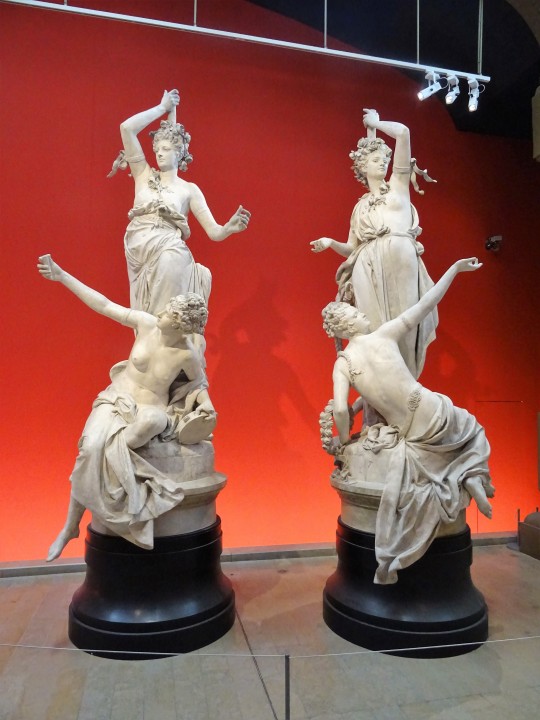
Torchère au tambourin & Torchère à la couronne. Albert-Ernest Carrier-Belleuse
To finish the morning, we headed towards the exit by way of the Allée centrale des sculptures, straight up the centre towards where we came in earlier. Several statues caught our eye, in particular three statues of African dudes in alabaster (we think). The contrast in colours made the depictions very dramatic and very life like. They were impressive to say the least.
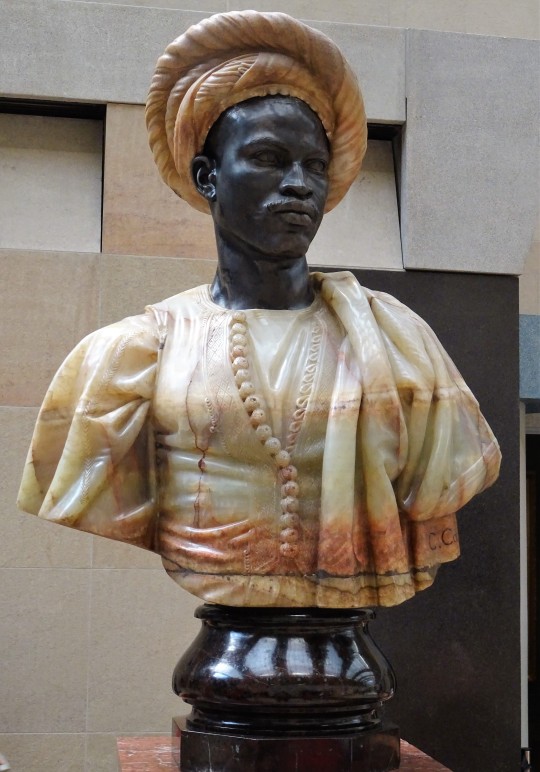
Nègre du Soudan, Charles Henri Joseph Cordier
Upon leaving the Orsay we didn't have to travel far for some tucker. In the laneway next to where we entered, on Rue de Lille, was the Royal Orsay Café. We first had a look at the menu and was going to walk away, probably because of the cost, but quickly about faced and went in for a quick refreshment. Next, we headed back across the Seine and into Jardin des Tuileries, turned left and headed down to the Musée de l'Orangerie via Allée Centrale, the wide central path through the gardens.

Resting at Bassin Octogonal. Looking towards Jeu de Paume
Built in 1852 to house the orange trees of the Tuileries Palace during winter, the Orangerie, along with Jeu de Paume, was assigned to the Under-Secretariat of State for Fine Arts after World War I, with the intention of housing an exhibition of living artists. It was at this point, although with one foot in the grave that Claud Monet got a guernsey. Offered to the French State at the conclusion of the war as a symbol of peace. His overly large set of Water Lilies has hung there ever since. This artwork is what greeted visitors, laid out in a circular room with bench seats in the middle facing each of the four separate panels. Each panel showed the changing seasons of the water lily pond at the bottom of Monet’s large garden. He sat down by the pond and worked on the pieces. It took 30 years for him to complete and has been on display in this gallery since 1927

Giving the "illusion of an endless whole, of a wave with no horizon and no shore". Monet's words, not ours
Another impressive display in the Orangerie was an exhibition that was acquired by the French State in the late fifties. It was called the Jean Walter and Paul Guillaume collection and belonged to their surviving wife, Domenica. Paul was a young and very successful French art dealer who prematurely met his demise, according to some at the hands of his unscrupulous wife, dying of an ulcer in his early forties. Apparently, she was nursing him and done a less than successful job. Her next husband, Jean, was a successful architect, not through being good at his trade but by detecting a lode of lead and zinc in Morocco in 1925. Ten years later he founded Société des mines de Zellidja which made him richer. Domenica married Jean in 1941, and he too died suspiciously after being run down by a car. This, with the fact that she hired a hitman to kill her step son led to the scuttlebutt that the State done a deal with her to bequeath her collection or face gaol. Good story, true or untrue. The collection currently comprises of works from Renoir, Cézanne, Gauguin, Monet and Sisley as well as Picasso and Matisse, amongst others.
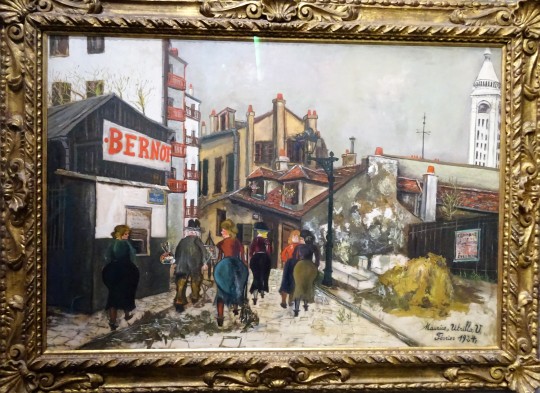
Maurice Utrillo, La Maison Bernot. 1924
This was an interesting display but it was time to move on, walking back through the gardens to the apartment for an hour. Once rested, we found ourselves looking to some old territory for dinner. Back across Jardin des Tuileries to Arc de Triomphe du Carrousel where the Africans were at it. Shane and Jo walked past and ignored them but they got Thomas with the string around the finger trick. They tie a colourful piece of string around the finger as a trick and when it cannot be removed, they hassle for money as it is "yours". It didn't work though as Jo intervened and hunted them away. As they retreated they yelled out that they were escaping from the "Australian Mumma". Over Pont des Arts, past Cathare, the Treasury building and up Rue de Seine to Bar du Marché for a beer and a feed. As it was, they had no food so after a couple we went shopping around the corner for some food and Jo and Cec taxied it back to the apartment with the groceries while Shane and the boys returned home the long way.

Enjoying Bar du Marché with its wall clad peeling mirrors
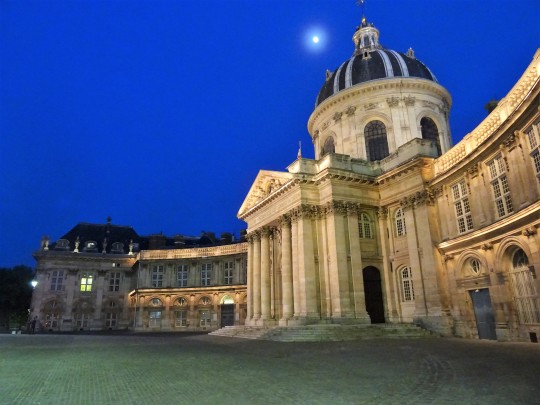
The Treasury Building
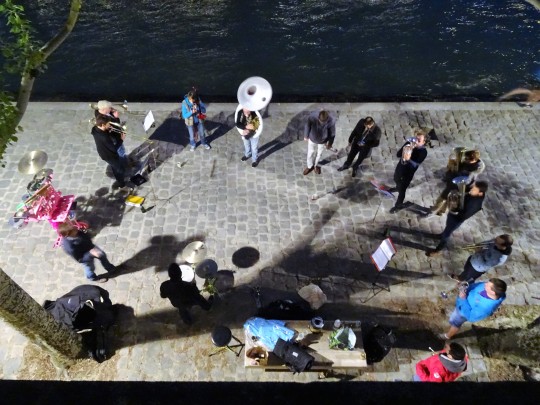
Entertainment below Quai de Conti
What a great day, a home cooked meal and tomorrow, Versailles.
1 note
·
View note
Text
Secretariat's hometown readies to mark 50th anniversary of Triple Crown win
The town of Paris, Kentucky will pay homage to legendary racehorse Secretariat with a life-size bronze sculpture and a three-storey mural featuring his 1973 Kentucky Derby win.
The project is a long-time dream for the community where Secretariat lived most of his life and where he is buried. It is scheduled to be completed on November 11, 2023 — exactly 50 years after Secretariat arrived at Claiborne Farm in Paris for his breeding career, and on the 50th anniversary of his Triple Crown Run.

Read more
0 notes
Text
Goa State Museum
Goa State Museum
Goa State Museum
This large, roomy museum
In a forlorn space near and around the Kadamba bus stand, there are huge numbers of galleries featuring Catholic art, Jain and Hindu sculptureand bronzes, and paintings including replica miniatures from all over India. The collection is immensely growing and interesting exhibits include an elaborately carved 16th-century table used in the…
View On WordPress
0 notes